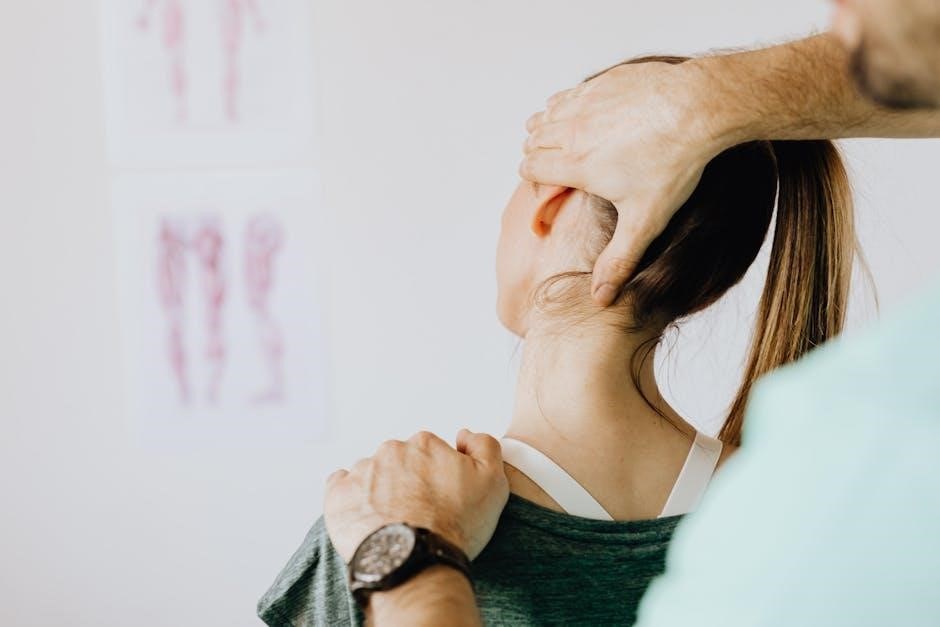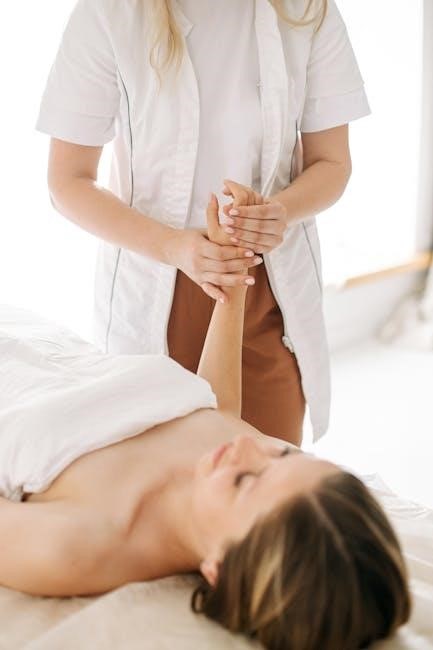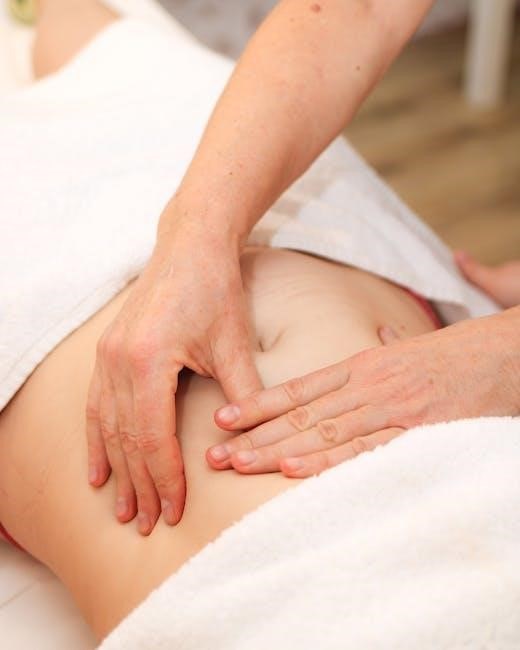Manual pelvic massage is a therapeutic technique focusing on the pelvic area to enhance overall well-being. It addresses physical, emotional, and sexual health through targeted, holistic practices. Widely used by physical therapists, massage specialists, and healthcare providers, it supports pelvic health, particularly during pregnancy, postpartum, and other life changes. This practice is gaining popularity for its effectiveness in alleviating discomfort and improving quality of life.
Overview of Pelvic Massage and Its Importance
Manual pelvic massage is a therapeutic practice that focuses on improving pelvic health by enhancing circulation, relaxing muscles, and addressing emotional blockages. It plays a crucial role in maintaining pelvic floor function, alleviating pain, and promoting overall well-being. This technique is valued for its holistic approach, addressing both physical and emotional aspects of health, making it a significant component of wellness routines.
Benefits of Manual Pelvic Massage
Manual pelvic massage offers numerous benefits, including improved circulation, muscle relaxation, and enhanced pelvic floor function. It also supports emotional well-being and sexual health, promoting overall vitality and comfort.
Physical Benefits: Improved Pelvic Health and Circulation
Manual pelvic massage enhances blood flow, promoting healthy tissue oxygenation and nutrient delivery. It relaxes tense muscles, improving pelvic floor function and reducing discomfort. Regular sessions can alleviate symptoms of pelvic floor dysfunction, such as pain or weakness, while supporting bladder and bowel health. This therapy also prepares the pelvis for childbirth and postpartum recovery.
Emotional and Mental Benefits: Reducing Stress and Anxiety
Manual pelvic massage fosters a deep sense of relaxation, calming the mind and body. By releasing physical tension, it helps reduce stress and anxiety, promoting emotional well-being. This practice encourages self-awareness and connection to the body, often leading to improved mental clarity and a sense of empowerment. It can also create a safe space for emotional release and healing.
Sexual Health Benefits: Enhancing Intimacy and Function
Manual pelvic massage can enhance sexual well-being by improving circulation, sensitivity, and arousal. It may address issues like pain during intimacy or difficulty achieving orgasm. By fostering relaxation and connection, it strengthens emotional bonds with partners, promoting a healthier and more fulfilling sexual experience while improving overall pelvic function and confidence.

Techniques and Methods of Manual Pelvic Massage
Manual pelvic massage employs techniques like soft tissue manipulation and trigger point therapy to enhance circulation, relax muscles, and improve pelvic health and overall well-being.
Soft Tissue Massage: Relaxing Muscles and Ligaments
Soft tissue massage in the pelvic region focuses on gentle manipulation of muscles and ligaments to reduce tension and promote relaxation. Techniques include long strokes, kneading, and pressure points to enhance blood flow and flexibility. This method is particularly effective for improving pelvic circulation and alleviating muscle stiffness, contributing to overall comfort and well-being.
Trigger Point Therapy: Releasing Tension in Specific Areas
Trigger point therapy targets specific knots or tight areas within pelvic muscles, using gentle, sustained pressure to release tension. This technique helps alleviate pain, improve circulation, and restore muscle function. By addressing localized discomfort, it enhances overall pelvic relaxation and mobility, making it a valuable component of manual pelvic massage for both therapeutic and preventative care.
Myofascial Release: Improving Pelvic Floor Flexibility
Myofascial release involves gentle, sustained pressure to release fascial restrictions, enhancing pelvic floor flexibility and reducing stiffness. This technique improves blood flow, eases chronic pain, and promotes relaxation. By targeting the connective tissues surrounding muscles and organs, it restores natural movement and balance, benefiting overall pelvic health and well-being through non-invasive, intuitive methods tailored to individual needs.

Target Areas for Manual Pelvic Massage
Manual pelvic massage focuses on key areas like the sacrum, lower back, muscles, and ligaments to relieve tension and support pelvic health effectively.
Key Muscles and Ligaments in the Pelvic Region
Manual pelvic massage targets the piriformis, iliopsoas, and pelvic floor muscles to relieve tension and improve circulation. Ligaments, such as the sacrotuberous and sacroiliac, are also addressed to enhance pelvic stability and mobility, promoting overall pelvic health and function.
The Role of the Sacrum and Lower Back
The sacrum and lower back play a crucial role in pelvic stability and mobility. Manual pelvic massage techniques, including soft tissue work and myofascial release, help alleviate sacral and lumbar tension, improving posture and reducing discomfort. This area’s relaxation enhances pelvic alignment and overall well-being, making it a key focus in pelvic massage therapy.
Abdominal and Pelvic Floor Muscles
Manual pelvic massage targets the abdominal and pelvic floor muscles to strengthen and restore their function. Techniques improve bladder control, posture, and core stability while addressing muscle imbalances. This focus is particularly beneficial during pregnancy and postpartum, helping to rebuild strength and reduce discomfort in these critical areas for overall pelvic and abdominal health.

When to Avoid Manual Pelvic Massage
Manual pelvic massage should be avoided during active infections, severe injuries, or acute pain. It is also contraindicated in certain medical conditions or immediately after surgery.
Contraindications and Precautions
Manual pelvic massage is contraindicated in cases of active infections, severe pelvic injuries, or acute inflammation. It should also be avoided during early pregnancy, immediately post-surgery, or with certain medical conditions. Consulting a healthcare provider is essential to ensure safe and appropriate application of this therapy.
Special Considerations for Pregnancy and Postpartum
Manual pelvic massage during pregnancy and postpartum requires specialized care. It can support pelvic health and prepare the body for childbirth but should be avoided in early pregnancy. Postpartum, it aids in recovery and healing. Skilled therapists adapt techniques to ensure safety and comfort, addressing specific needs during these sensitive life stages.
How to Find a Qualified Specialist
Seek professionals with certifications in pelvic massage, ensuring they have experience in pelvic health and verifiable credentials to ensure safe and effective treatment.
Tips for Locating a Trained Pelvic Massage Therapist
Research local therapists specializing in pelvic health, checking for certifications in modalities like myofascial release or trigger point therapy. Read reviews, ask for referrals from healthcare providers, and ensure they have experience with pelvic-specific treatments. Verify credentials and schedule a consultation to discuss your needs and comfort level before committing to sessions.
Questions to Ask Your Therapist
Ask about their experience with pelvic massage, specific techniques they use, and how they address your unique needs. Inquire about their approach to pain management and aftercare. Clarify their policy on communication during sessions and how they ensure comfort. Also, ask for references or success stories from previous clients to gauge their expertise and suitability for your condition.
Safety Guidelines and Aftercare
Ensure open communication during sessions and address any discomfort promptly. Stay hydrated post-massage and avoid strenuous activities. Rest and monitor bodily sensations to support recovery.
Preparing for Your First Session
Arrive 10-15 minutes early to complete paperwork and discuss goals. Wear comfortable clothing and consider a light meal beforehand. Stay hydrated to enhance circulation. Communicate openly with your therapist about medical history, discomfort, or concerns. Establish boundaries and ask questions to ensure comfort. Mental preparation, such as deep breathing, can reduce anxiety and maximize benefits.
Post-Massage Care and Recovery
Hydrate to flush toxins and support circulation. Rest or engage in light activities to allow muscles to recover. Avoid strenuous exercise for 24 hours. Be mindful of emotional releases, as massage can trigger feelings. Monitor physical sensations and note improvements. Follow therapist recommendations for stretching or self-care routines to enhance recovery and maintain benefits.
When to Stop or Adjust the Massage
If experiencing pain, numbness, or discomfort, inform your therapist immediately. Adjust pressure or technique to ensure comfort. Stop if breathing becomes difficult or dizziness occurs. Emotional releases may require pausing the session. Communication is key; prioritize your well-being by speaking up. Adjustments ensure a safe and beneficial experience tailored to your needs and comfort level.

Incorporating Manual Pelvic Massage into Your Wellness Routine
Regular manual pelvic massage can enhance overall well-being by improving circulation, reducing tension, and promoting relaxation. Incorporate it into your routine with daily exercises and professional guidance.
Daily Exercises and Self-Care Practices
Daily pelvic floor exercises, such as Kegels, and gentle stretching can complement manual pelvic massage. Incorporate self-care practices like deep breathing, yoga, and mindful movement to enhance relaxation and pelvic health. Consistency is key to improving circulation, reducing tension, and promoting overall well-being. These routines can be tailored to suit individual needs and lifestyles for optimal results.
Combining with Other Therapies for Optimal Results
Manual pelvic massage can be enhanced by integrating it with other therapies, such as acupuncture, breathwork, or physical therapy. These combinations help address both physical and emotional aspects of pelvic health. For example, pairing massage with yoga or Pilates can improve flexibility and strength. A holistic approach, guided by a healthcare provider, ensures personalized and effective care for long-term well-being.
Tracking Progress and Long-Term Benefits
Tracking progress in manual pelvic massage involves monitoring improvements in pelvic comfort, strength, and overall well-being. Regular sessions can lead to long-term benefits, such as enhanced pelvic floor stability and reduced chronic pain. Keeping a journal or working with a therapist to document changes helps maintain consistency and maximize results over time.
Manual pelvic massage offers a holistic approach to pelvic health, empowering individuals to improve well-being. Regular practice can provide relief, enhance strength, and promote long-term wellness.
Final Thoughts on the Value of Manual Pelvic Massage
Manual pelvic massage is a transformative practice offering holistic benefits for physical, emotional, and sexual well-being. It empowers individuals to take charge of their pelvic health, fostering relief, strength, and vitality. Suitable for various life stages, it provides a natural, non-invasive approach to enhancing quality of life. Embracing this practice can lead to profound, long-lasting positive changes in overall wellness.
Encouragement to Explore and Embrace This Practice
Embrace manual pelvic massage as a natural, empowering practice to enhance your well-being. It offers a non-invasive way to address pelvic health, suitable for various life stages. By taking charge of your pelvic health, you can experience relief, strength, and vitality. Consider consulting a trained specialist to explore its benefits and improve your quality of life meaningfully.


0 Comments